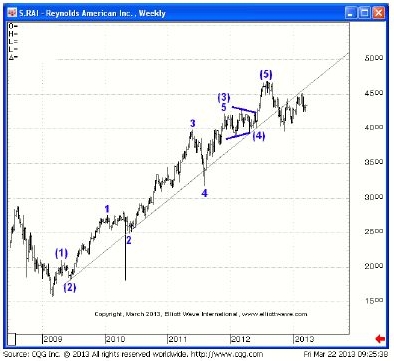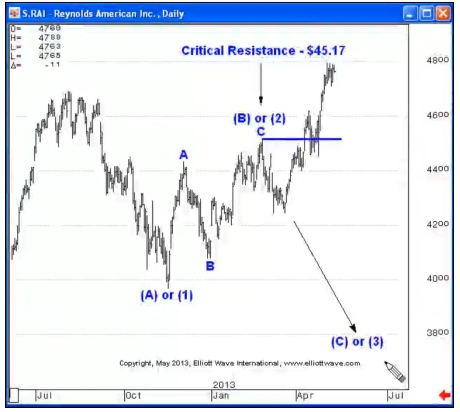Examples from Whole Foods Market and Reynolds American, Inc show you what to do (or not) to trade successfully with Elliott Wave
By Elliott Wave International
After 20 years of experience applying the Elliott Wave Principle, Senior Analyst Jeffrey Kennedy says that it remains the one tool that will tell him — down to the tick, to the pip, even to the penny – when his forecast is no longer viable.
That, according to Kennedy, is one of the two most important keys to successful trading:
“Know where you are wrong.”
In his May 8 Elliott Wave Junctures educational video, Kennedy shows subscribers how to acquire that knowledge when revisiting an earlier forecast that didn’t work out. This lesson was adapted from our EWJ service, and also explores the second of Kennedy’s Keys to Successful Trading:
“Don’t pick tops and bottoms.”
See the logic behind Kennedy’s wisdom by reviewing his analysis of Whole Foods Market, Inc. (WFM) and Reynolds American, Inc. (RAI).
My outlook for Whole Foods Market was right and my outlook for Reynolds American was wrong. While price evidence was compelling for both issues, the forecast in WFM was in the direction of the trend and RAI’s incorporated top picking. Here’s what happened:
On May 1, price evidence called for new highs in Whole Foods Market. We had a clearly defined uptrend, a three wave move in the direction opposite the primary trend, and the move to the downside was contained within parallel lines:
Additionally, we had a double closed-key reversal when the low was made, as well as some bullish divergence on the smaller timeframes. Price evidence was very strong that this market would continue to new all-time highs, so my outlook was bullish.
The bullish outlook in WFM required the April low of $81.39 to hold. The trend was clearly up from 2009 into 2013. From an Elliott Wave perspective we knew that this was a countertrend move with an A-B-C structure (a corrective wave pattern within a larger trending market). We had the wind at our back and were not “picking a top.” We simply looked at the price evidence in support of a further rally.
Conversely, the following example in Reynolds America, Inc. did not work out.
On March 22, I anticipated a move to the downside in Reynolds American, Inc. as we had a five-wave decline and a subsequent advance that was a three-wave move. I was looking for a tradable selloff to the downside in wave (C) or wave (3):
Unlike the successful WFA example, I was not trading with the trend. Instead, I was looking for a “top.”
Yet I was able to prevent a losing trade from becoming a devastating trade because I could use the Elliott Wave Principle to “know where I was wrong.”
This bearish wave pattern was viable only as long as prices held below the February high of $45.17.
Once prices exceeded this critical resistance, I knew not to look to the downside – that my outlook was no longer viable:
 |
Learn to Find Opportunities in the Markets You Follow with Jeffrey Kennedy’s 47-page eBook: How to Spot Trading Opportunities – It’s FREE until June 3!Now’s your chance to discover a whole new way to analyze charts and spot high-confidence trade setups using technical analysis. For a limited time, you can download EWI’s 47-page How to Spot Trading Opportunities eBook for FREE! ($79 value). This offer expires June 3.Download Your FREE eBook Now >> |
This article was syndicated by Elliott Wave International and was originally published under the headline The 2 Most Important Keys to Successful Trading. EWI is the
world’s largest market forecasting firm. Its staff of full-time analysts led by Chartered Market Technician Robert Prechter provides 24-hour-a-day market analysis to
institutional and private investors around the world.



Speak Your Mind